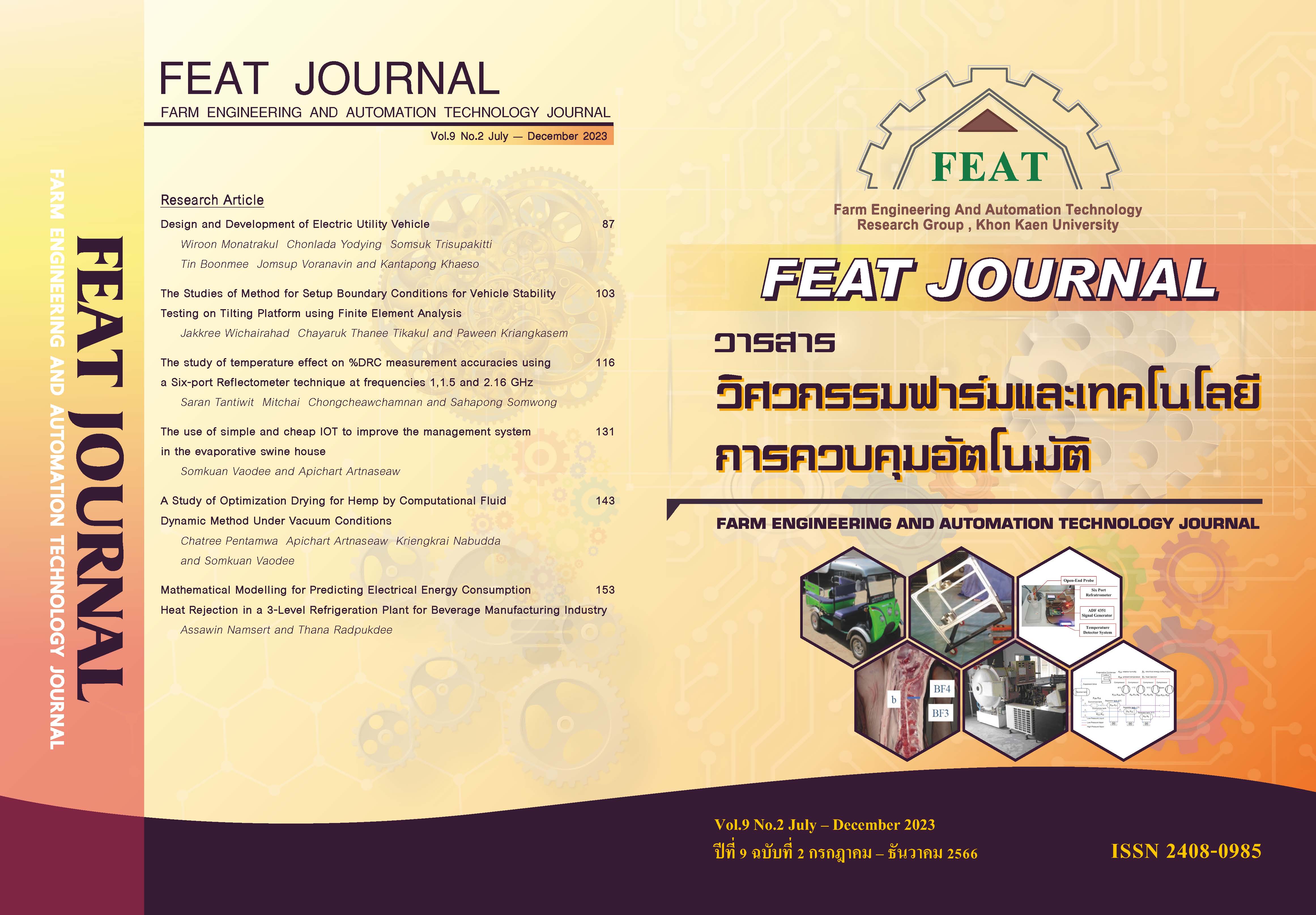การศึกษาวิธีการกำหนดเงื่อนไขขอบเขตสำหรับการทดสอบเสถียรภาพ ของยานยนต์บนพื้นเอียงด้วยระเบียบวิธีไฟไนต์เอเลเมนต์
Main Article Content
บทคัดย่อ
เสถียรภาพบนพื้นเอียงหรือความสามารถในการทรงตัวบนพื้นเอียงของโครงสร้างยานยนต์ เป็นองค์ประกอบสำคัญของความปลอดภัย โดยเฉพาะรถที่ใช้ในการขนส่งผู้โดยสาร และรถบรรทุกใช้งานเกษตรกรรม (รย.15) วิธีการทดสอบเสถียรภาพบนพื้นเอียงสามารถกระทำได้โดยการนำยานยนต์จริงไปทดสอบที่เครื่องทดสอบการทรงตัวบนพื้นเอียง เพื่อเป็นการลดความสูญเปล่าจากการนำยานยนต์จริงไปทดสอบเสถียรภาพบนพื้นเอียงแล้วไม่ผ่านการทดสอบตามเกณฑ์ ระเบียบวิธีไฟไนต์เอเลเมนต์จึงได้ถูกนำมาใช้ในการวิเคราะห์โครงสร้างด้วยคอมพิวเตอร์ช่วยวิเคราะห์ทางวิศวกรรมก่อนทำการผลิตโครงสร้างจริง บทความนี้จึงได้นำเสนอวิธีการในการกำหนดเงื่อนไขขอบเขตสำหรับการวิเคราะห์มุมเอียงที่ทำให้โครงสร้างยานยนต์พลิกคว่ำด้วยคอมพิวเตอร์ช่วยวิเคราะห์ทางวิศวกรรม โดยวิเคราะห์ภายใต้สมมติฐานภาระกระทำแบบสถิตศาสตร์และสมบัติวัสดุแบบยืดหยุ่นเชิงเส้น ผลการวิเคราะห์ด้วยคอมพิวเตอร์ช่วยวิเคราะห์ทางวิศวกรรมได้ถูกเปรียบเทียบกับผลการทดสอบเสถียรภาพบนพื้นเอียงของโครงสร้างจริงที่เป็นโครงสร้างอย่างง่าย เมื่อวิเคราะห์ด้วยการกำหนดเงื่อนไขขอบเขตแบบที่ 1 ผลปรากฏว่ามีค่าความคลาดเคลื่อนสูงสุดถึงร้อยละ 63.63 และปรากฏว่ามีค่าความคลาดเคลื่อนสูงสุดเพียงร้อยละ 2.42 เมื่อทำการปรับปรุงวิธีการตั้งค่าเงื่อนไขขอบเขตเป็นแบบที่ 2 คณะผู้วิจัยคาดหวังว่าการศึกษานี้จะเป็นประโยชน์ต่อผู้ใช้ยานยนต์ในด้านของความปลอดภัยของโครงสร้างและเป็นประโยชน์ต่อผู้ผลิตยานยนต์ในด้านของการออกแบบและผลิต
Article Details

This work is licensed under a Creative Commons Attribution-NonCommercial-NoDerivatives 4.0 International License.
วารสารวิศวกรรมฟาร์มและเทคโนโลยีควบคุมอัตโนมัติ (FEAT Journal) มีกําหนดออกเป็นราย 6 เดือน คือ มกราคม - มิถุนายน และกรกฎาคม - ธันวาคม ของทุกปี จัดพิมพ์โดยกลุ่มวิจัยวิศวกรรมฟาร์มและเทคโนโลยีควบคุมอัตโนมัติ คณะวิศวกรรมศาสตร์มหาวิทยาลัยขอนแก่น เพื่อเป็นการส่งเสริมและเผยแพร่ความรู้ ผลงานทางวิชาการ งานวิจัยทางด้านวิศวกรรมศาสตร์และเทคโนโลยีพร้อมทั้งยังจัดส่ง เผยแพร่ตามสถาบันการศึกษาต่างๆ ในประเทศด้วย บทความที่ตีพิมพ์ลงในวารสาร FEAT ทุกบทความนั้นจะต้องผ่านความเห็นชอบจากผู้ทรงคุณวุฒิในสาขาที่เกี่ยวข้องและสงวนสิทธิ์ ตาม พ.ร.บ. ลิขสิทธิ์ พ.ศ. 2535
References
ประกาศกรมการขนส่งทางบก. กำหนดเกณฑ์การทรงตัวของรถที่ใช้ในการขนส่งผู้โดยสาร. ราชกิจจานุเบกษา เล่ม 129 ตอนพิเศษ 81 ง หน้า 27: กรุงเทพมหานคร; 2555.
United Nations Economic Commission for Europe (UNECE). Addendum 106: Regulation No. 107 Uniform provisions concerning the approval of category M2 or M3 vehicles with regard to their general construction. Revision3: 2011.
Isermann H. Overturning Limits of Articulated Vehicles with Solid and Liquid Loads. Motor Industry Research Association. 1970; Translation No. 58/70.
Norstrom O and Nordmark S. Test Procedure for the Evaluation of the Lateral Dynamics of Commercial Vehicle Combination. Automobile Industry. 1978; 23(2): 63-9.
Mai L and Sweatman P. Articulated Vehicle Stability – Phase II Tilt Test and Computer Model. Australian Road Research Board. 1984; AIR 323-2.
ประกาศกระทรวงอุตสาหกรรม. ฉบับที่ 2093 (พ.ศ. 2538) ออกตามความในพระราชบัญญัติมาตรฐานผลิตภัณฑ์อุตสาหกรรม พ.ศ. 2511 เรื่อง กำหนดมาตรฐานผลิตภัณฑ์อุตสาหกรรม รถใช้งานเกษตรกรรม รถขนส่งเกษตร. ราชกิจจานุเบกษา เล่ม 112 ตอนที่ 103ง. หน้า 63-80: กรุงเทพมหานคร; 2538.
Transit Office Florida Department of Transportation. Crash and Safety Testing Standard for Paratransit Buses. 2nd ed. Acquired by the State of Florida; 2007.
Davis M and Marting P. Predicting Vehicle Rollover Propensity. International Truck and Bus Meeting and Exhibition Detroit; 2002 November 18-20; Michigan, United States of America: 2002.
Wichairahad J, Kaewsarn P, Nisapai W, Tan-Intara-Art S and Chanwiang W. The strength analysis of an agriculture truck chassis using finite element method. Engineering and Applied Science Research. 2016; 43(S2): 267-70.
Wichairahad J, Nisapai W, Kangkham K, Chanwiang W and Sutthi R. The Strength and Stiffness Analysis of Agricultural Truck Chassis using Finite Element Analysis by Flexible Joint Beam Element. Farm Engineering and Automation Technology. 2019; 5(1): 35-48.
United Nations Economic Commission for Europe (UNECE). Addendum 65: Regulation No. 66 Uniform technical prescriptions concerning the approval of large passenger vehicles with regard to the strength of their superstructure. 1st ed; 2006.
National Highway Traffic Safety Administration (NHTS. U.S. Department of Transportation. FMVSS220 Standard School Bus Rollover Protection. Washington DC, United States of America: 1991.
Prochowski L, Zielonka K and Muszynski A. Analysis of the process of double-deck bus rollover at the avoidance of an obstacle having suddenly sprung up. Journal of KONES. 2012; 19: 371-80.
Croccolo D, Agostinis MD and Vincenzi N. Structural Analysis of an Articulated Urban Bus Chassis via FEM: a Methodology Applied to a case study. Journal of Mechanical Engineering 2011; 57(11): 799-809.
Zhilin J, Jingxuan L, Yanjun H and Amir K. Study on Rollover Index and Stability for a Triaxle Bus. Chinese Journal of Mechanical Engineering. 2019; 32: 1-15.
Zulkipli ZH, Mohd Faudzi SA and Abdul Manap AR. Factors Affecting Bus Rollover. Journal of the Society of Automotive Engineers Malaysia. 2019; 3(4): 2-7.
Shun T, Lang W, Chris S, WenCai Z, Yuan J and YanQin C. An Earlier Predictive Rollover Index Designed for Bus Rollover Detection and Prevention. Journal of Advanced Transportation. 2018; 1-10.
Thanaporn T and Supakit R. Influence of suspension parameters on a tilt angle of passenger bus for the stability test. Science, Engineering and Health Studies. 2020; 14(2): 101-108.
Liang CC and Le GN. Analysis of Bus Rollover Protection under Legislated Standard using LS-DYNA Software Simulation Techniques. International Journal of Automotive Technology. 2010; 11(4): 194-506.
Jiantao B, Guangwei M and Wenjie Z. Rollover crashworthiness analysis and optimization of bus frame for conceptual design. Journal of Mechanical Science and Technology. 2019; 33(7): 3363-73.

